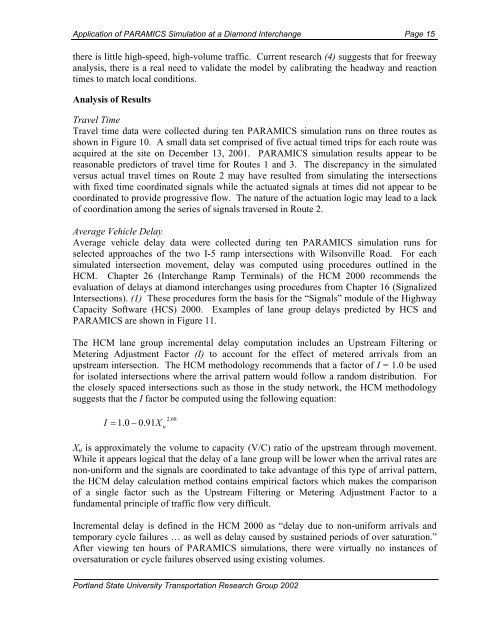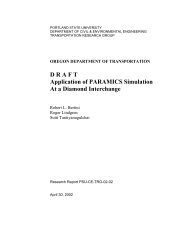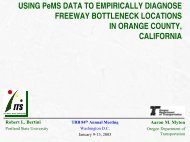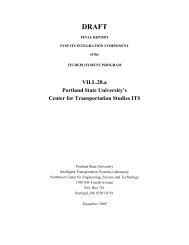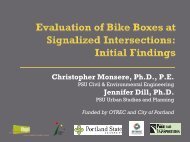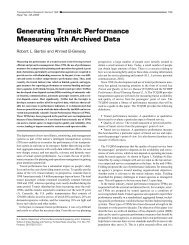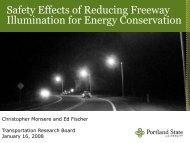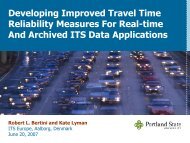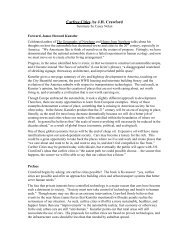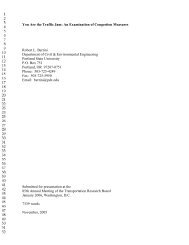Application of Paramics Simulation to a Diamond Interchange
Application of Paramics Simulation to a Diamond Interchange
Application of Paramics Simulation to a Diamond Interchange
You also want an ePaper? Increase the reach of your titles
YUMPU automatically turns print PDFs into web optimized ePapers that Google loves.
<strong>Application</strong> <strong>of</strong> PARAMICS <strong>Simulation</strong> at a <strong>Diamond</strong> <strong>Interchange</strong> Page 15<br />
there is little high-speed, high-volume traffic. Current research (4) suggests that for freeway<br />
analysis, there is a real need <strong>to</strong> validate the model by calibrating the headway and reaction<br />
times <strong>to</strong> match local conditions.<br />
Analysis <strong>of</strong> Results<br />
Travel Time<br />
Travel time data were collected during ten PARAMICS simulation runs on three routes as<br />
shown in Figure 10. A small data set comprised <strong>of</strong> five actual timed trips for each route was<br />
acquired at the site on December 13, 2001. PARAMICS simulation results appear <strong>to</strong> be<br />
reasonable predic<strong>to</strong>rs <strong>of</strong> travel time for Routes 1 and 3. The discrepancy in the simulated<br />
versus actual travel times on Route 2 may have resulted from simulating the intersections<br />
with fixed time coordinated signals while the actuated signals at times did not appear <strong>to</strong> be<br />
coordinated <strong>to</strong> provide progressive flow. The nature <strong>of</strong> the actuation logic may lead <strong>to</strong> a lack<br />
<strong>of</strong> coordination among the series <strong>of</strong> signals traversed in Route 2.<br />
Average Vehicle Delay<br />
Average vehicle delay data were collected during ten PARAMICS simulation runs for<br />
selected approaches <strong>of</strong> the two I-5 ramp intersections with Wilsonville Road. For each<br />
simulated intersection movement, delay was computed using procedures outlined in the<br />
HCM. Chapter 26 (<strong>Interchange</strong> Ramp Terminals) <strong>of</strong> the HCM 2000 recommends the<br />
evaluation <strong>of</strong> delays at diamond interchanges using procedures from Chapter 16 (Signalized<br />
Intersections). (1) These procedures form the basis for the “Signals” module <strong>of</strong> the Highway<br />
Capacity S<strong>of</strong>tware (HCS) 2000. Examples <strong>of</strong> lane group delays predicted by HCS and<br />
PARAMICS are shown in Figure 11.<br />
The HCM lane group incremental delay computation includes an Upstream Filtering or<br />
Metering Adjustment Fac<strong>to</strong>r (I) <strong>to</strong> account for the effect <strong>of</strong> metered arrivals from an<br />
upstream intersection. The HCM methodology recommends that a fac<strong>to</strong>r <strong>of</strong> I = 1.0 be used<br />
for isolated intersections where the arrival pattern would follow a random distribution. For<br />
the closely spaced intersections such as those in the study network, the HCM methodology<br />
suggests that the I fac<strong>to</strong>r be computed using the following equation:<br />
I<br />
=<br />
2.68<br />
1.0<br />
− 0.91X<br />
u<br />
X u is approximately the volume <strong>to</strong> capacity (V/C) ratio <strong>of</strong> the upstream through movement.<br />
While it appears logical that the delay <strong>of</strong> a lane group will be lower when the arrival rates are<br />
non-uniform and the signals are coordinated <strong>to</strong> take advantage <strong>of</strong> this type <strong>of</strong> arrival pattern,<br />
the HCM delay calculation method contains empirical fac<strong>to</strong>rs which makes the comparison<br />
<strong>of</strong> a single fac<strong>to</strong>r such as the Upstream Filtering or Metering Adjustment Fac<strong>to</strong>r <strong>to</strong> a<br />
fundamental principle <strong>of</strong> traffic flow very difficult.<br />
Incremental delay is defined in the HCM 2000 as “delay due <strong>to</strong> non-uniform arrivals and<br />
temporary cycle failures … as well as delay caused by sustained periods <strong>of</strong> over saturation.”<br />
After viewing ten hours <strong>of</strong> PARAMICS simulations, there were virtually no instances <strong>of</strong><br />
oversaturation or cycle failures observed using existing volumes.<br />
Portland State University Transportation Research Group 2002


